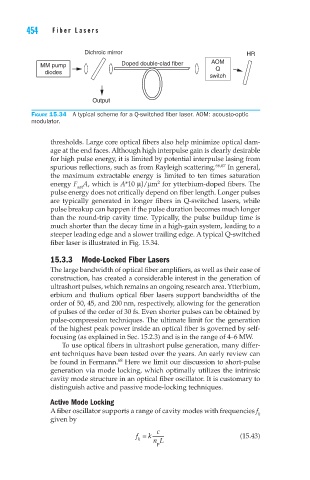Page 486 - High Power Laser Handbook
P. 486
454 Fi b er L a s er s Intr oduction to Optical Fiber Lasers 455
Dichroic mirror HR
MM pump Doped double-clad fiber AOM
diodes Q
switch
Output
Figure 15.34 A typical scheme for a Q-switched fiber laser. AOM: acousto-optic
modulator.
thresholds. Large core optical fibers also help minimize optical dam-
age at the end faces. Although high interpulse gain is clearly desirable
for high pulse energy, it is limited by potential interpulse lasing from
spurious reflections, such as from Rayleigh scattering. 66,67 In general,
the maximum extractable energy is limited to ten times saturation
energy F A, which is A*10 µJ/µm for ytterbium-doped fibers. The
2
sat
pulse energy does not critically depend on fiber length. Longer pulses
are typically generated in longer fibers in Q-switched lasers, while
pulse breakup can happen if the pulse duration becomes much longer
than the round-trip cavity time. Typically, the pulse buildup time is
much shorter than the decay time in a high-gain system, leading to a
steeper leading edge and a slower trailing edge. A typical Q-switched
fiber laser is illustrated in Fig. 15.34.
15.3.3 Mode-Locked Fiber Lasers
The large bandwidth of optical fiber amplifiers, as well as their ease of
construction, has created a considerable interest in the generation of
ultrashort pulses, which remains an ongoing research area. Ytterbium,
erbium and thulium optical fiber lasers support bandwidths of the
order of 50, 45, and 200 nm, respectively, allowing for the generation
of pulses of the order of 30 fs. Even shorter pulses can be obtained by
pulse-compression techniques. The ultimate limit for the generation
of the highest peak power inside an optical fiber is governed by self-
focusing (as explained in Sec. 15.2.3) and is in the range of 4–6 MW.
To use optical fibers in ultrashort pulse generation, many differ-
ent techniques have been tested over the years. An early review can
be found in Fermann. Here we limit our discussion to short-pulse
68
generation via mode locking, which optimally utilizes the intrinsic
cavity mode structure in an optical fiber oscillator. It is customary to
distinguish active and passive mode-locking techniques.
Active Mode Locking
A fiber oscillator supports a range of cavity modes with frequencies f
k
given by
c
f = k nL (15.43)
k
p

